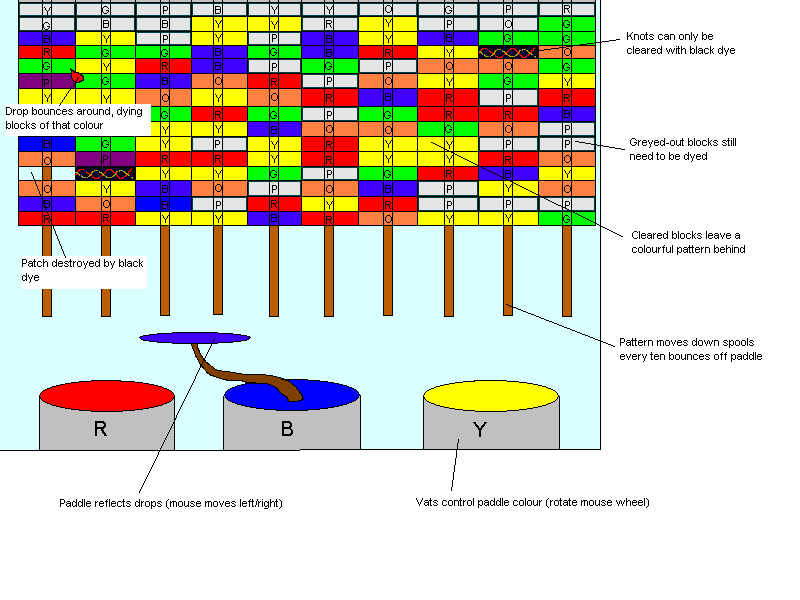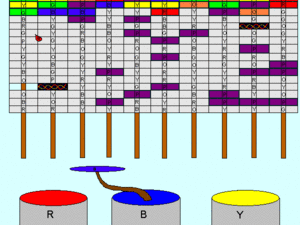GCPP:Proposal-Barbel
Puzzle Codename: Barbel
| Contact | |
| Username: | deathprog23 |
| Additional contact info: | Oneiropoios on Midnight, Hooke on Viridian, p.j.howard@rhul.ac.uk |
| Project forum thread: | |
Game concept
Arkanoid with combos meets Space invaders, or Rumble meets Alchemistry! Dye sections of cloth by bouncing drops off a paddle.
Objective
Clear as much of the board as possible before the cloth reaches the bottom of the spools.
Gameplay
The game starts with a couple of rows of randomly-generated cloth patches at the top of the screen. These have a desired colour indicated by a symbol (letters in the diagram below) and by tinting to the otherwise-grey shading (not included in the diagram).
The player selects one of three colours for a paddle (which moves via the mouse from left to right) at the bottom of the screen, and then clicks to launch a drop of that colour.
The drop bounces off blocks of other colours, and passes through those of its own, dying them as it runs over. On returning to the bottom of the screen, it is either lost, or bounced back up by the paddle. Bounces from near the centre of the paddle are specular, bounces from closer to its edges are at angles increased in that direction.
The drop changes colour at each bounce off the paddle according to which colour is selected, and the following rules (essentially the standard rules for combining paint colours):
| Incoming drop colour | Paddle colour |
|
| Red | Red
Blue Yellow | Red
Purple Orange |
| Blue | Red
Blue Yellow | Purple
Blue Green |
| Yellow | Red
Blue Yellow | Orange
Green Yellow |
| Green | Red
Blue Yellow | Black
Blue Yellow |
| Orange | Red
Blue Yellow | Red
Black Yellow |
| Purple | Red
Blue Yellow | Red
Blue Black |
Every tenth bounce off the paddle, a new randomly generated row of patches is generated at the top of the screen (the player can always see the edge of the next row due, though not dye it), and the rest move down the spools one row.
Scoring
Points gained for each patch dyed. Extra points for secondary colours. Lots of points for clearing knots. Points lost for losing drops off the bottom of the screen, for ruining patches with black dye and for each block left undyed at the end of the game. Combo multiplyers for successive clears of the same colour. Bigger combo multiplyer for successive clears of different colours (one bounce off paddle allowed between each).
Variability
Each row is randomly generated. As more rows push the cloth down the screen, it will become easier to direct the drops into regions where they will dye many patches before returning to the bottom, as well as making larger combos possible. Higher difficulties include knotted patches which are more risky to clear as well as involving more colours, spools and rows.
End criteria
When the rows reach the bottom of the spools, the puzzle ends. The last time the rows move down, there will be no edges of new patches at the top of the screen, and a warning chime will sound. Puzzles at lower difficulties require fewer rows for completion. The diagram below shows a game which will have about twenty rows.
Difficulty scaling
- At low rankings, there will be fewer spools and fewer rows required for completion. Also, the first few puzzles will not include secondary colours, as in Alchemistry.
- Later puzzles will include random 'knots', which can only be cleared with black dye (all three colours). Black dye is dangerous though; if it hits any other patch, it will ruin it and that patch will be removed from the game (see diagram). A black drop dissolves in a pop after hitting one block only.
- It is also possible to reward complex pattern making with bonuses. For example, dying a red , then a blue, then an yellow in order could award a small bonus. Or dying one of each colour in order could activate a 'multidrop' feature. Possibly random bonuses or 'power-ups' could be awarded for clearing knots, though it would be more fun to require skilled manipulation of the game for these I feel.
- The speed of the bouncing drops should also increase with skill, as in Gunnery.
Crafting type
Weaving, though this obviously corresponds to the dying part of that trade rather than the weaving itself.
Known problems
- The scaling of game length needs to be determined. The number of bounces between row drops can be altered to make this satisfactory. Currently, twenty rows times ten bounces per row, at perhaps one bounce every second on average gives a (high-end) game length of under five minutes.
- Identification of what colour patches are and which are to be dyed and which have been already dyed is not clear in my diagram. I feel better arrt would improve this situation. I feel the puzzle is more 'natural' when it involves changing greyed-out patches to coloured ones, though the background pattern this leaves may be confusing. Again I think better arrt would solve this, but include a diagram where I've reversed the role of the grey patches and the coloured ones (you need to bounce drops off patches which are the corresponding colour) for clarity.
- The drops may get trapped in areas away from the paddle. Any drop should have a maximum lifetime of bounces off any surface to avoid this being problematic (e.g. 20 bounces away from the bat?).
- A 'perfect' score may be possible, so combo multiplyers need to be scaled to make different styles rewarding and to make decisions non-trivial.
- At the other end of the scale, it may be too difficult to provide basic labour. The scaling of puzzle elements with rank should help with this.
- This proposal has a more 'arcadey' feel than most. However, I think it would be less stressful than Distilling, with its fixed time between row generation. Unlike breakout/arkanoid the emphasis here is on setting up and making combos, not one's ability to keep a fast-moving ball off the bottom of the screen.
Notes
Images

